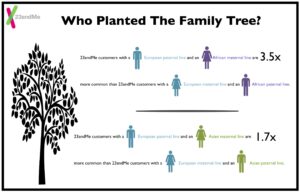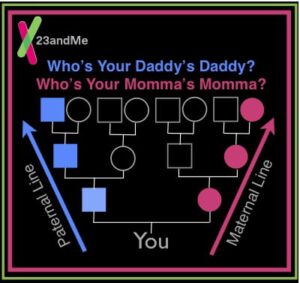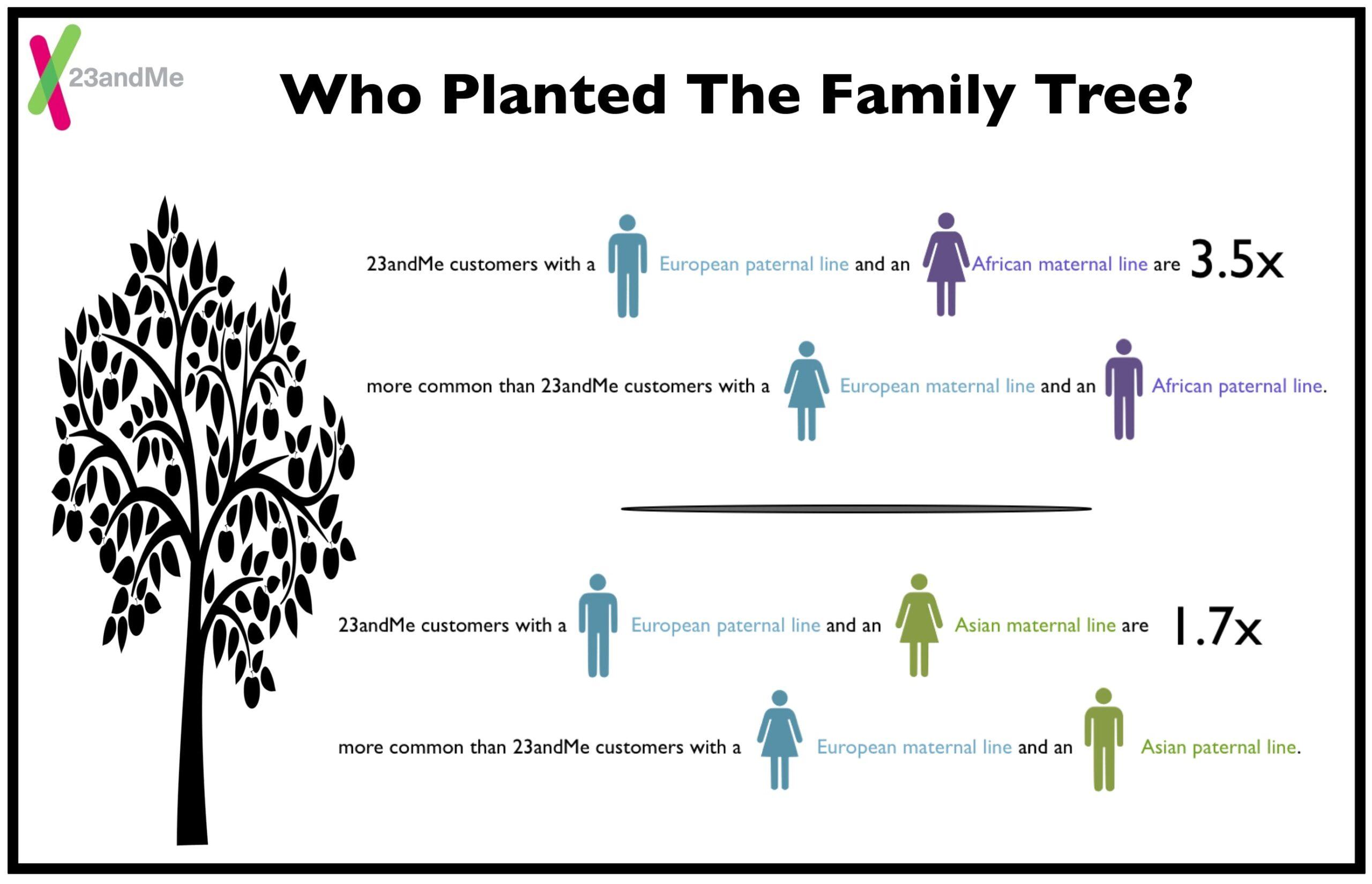by Emily Chang, Joanna Mountain, and Mike Macpherson

Click on the image above for a larger version of this chart, which shows that some ancestry combinations are more common than others in the 23andMe database.
Given the United States’s “melting pot” nature, it is not surprising that most Americans have mixed ancestry.
Like many of my fellow citizens, my ancestry is a long recipe: a bit of English, a dash of German, a pinch of Hungarian. Should my husband and I have kids, my children will have Chinese ancestry, too. Such mixed ancestry is becoming increasingly the norm, and genetics turns out to be a very useful tool to explore it.
Traditionally, genetic ancestry focused on two particular pieces of DNA, mitochondrial DNA and the Y-chromosome. Your maternal line includes your mother, your maternal grandmother, her mother before her, and so on; likewise, your paternal line includes your father, your paternal father, his father before him, and so on. The paternal line is determined using the Y chromosome, which determines whether a person is male and only men can pass down. The maternal line is determined using the DNA found inside mitochondria, small energy-producing cellular machines with their own genetic blueprints.
Both men and women have mitochondrial DNA, but only women pass on their mitochondrial DNA to children.
These days, genetic ancestry tools like 23andMe use DNA from all of your 23 pairs of chromosomes to offer insights into your heritage. However, information about maternal and paternal lines, which can reflect ancestral origins, can yield interesting insights.
 This figure shows the paternal line in blue and the maternal line in pink. Your maternal grandmother and paternal grandfather are members of your maternal and paternal lines, respectively.
This figure shows the paternal line in blue and the maternal line in pink. Your maternal grandmother and paternal grandfather are members of your maternal and paternal lines, respectively.
Our large customer database shows that some ancestry combinations are more common than others among our customers. Given a pair of ancestral origins, there are two ways to combine the maternal and paternal lines: a maternal line of the first ancestry with a paternal line of the second ancestry or a paternal line of the first ancestry with a maternal line of the second ancestry.
Our database shows that these two ways of combining the maternal and paternal lines are not equally common, indicating gender trends in mating. For instance, about 3.5 times as many 23andMe customers have a maternal line indicative of African ancestry and a paternal line indicative of European ancestry than the reverse. This mating trend probably reflects, in part, a disgraceful period in the United States’ past in which white male slave owners fathered children with enslaved African American women rather than recent trends in interracial marriages. More recent marriage patterns actually reflect a trend in the opposite direction.
The 2010 US census shows that a “white” wife and “black” husband is 2.3 times more common than a “white” husband and “black” wife [note: the terms “black” and “white” were the descriptors used in the US census report].
The maternal and paternal lines of the 23andMe customers, thus, tell the sad truth of the treatment of enslaved African American women. In one episode of the television program Finding Your Roots, Condoleezza Rice says this aspect of United States history is an “unhealed wound in America” and that we have trouble talking about what really happened during slavery. She is right. Most of us would rather not talk about the rape of enslaved African American women, but DNA isn’t shy about addressing this ugly truth. As we study and learn about these genetic patterns, we face one of the most disturbing aspects of United States history — a vital step towards healing that unhealed wound to which Rice referred.
![]() Learn more about your ancestry in your 23andMe account.
Learn more about your ancestry in your 23andMe account.
Not yet a customer? Visit our store or learn more.
A similar but less extreme pattern was observed for individuals of Asian and European ancestry; about 1.7 times as many 23andMe customers have a European paternal line in conjunction with an Asian maternal line than have an Asian paternal line with a European maternal line. The reason for this particular mating trend can not be traced to slavery and may have more complex sociological and historical origins. Regardless of its source, however, the trend is supported by other studies. The large PEW study on interracial marriage released this past February which observed that Asian American women were more likely to have an interracial marriage than Asian American men, and the US Census Bureau, which captures a wider segment of our society than the 23andMe database, shows an even stronger trend — a “white” husband and “Asian” wife is 2.4 times more common than a “white” wife and “Asian” husband [note: the terms “Asian” and “white” were the descriptors used in the US census report].
Our DNA holds a lot of information. It tells us who we are and who we, collectively, were. The mating trends seen in the maternal and paternal lines of 23andMe customers reflect complex sociological and historical truths, even some historical truths that are difficult to face. Genetics helps us learn more about who we are and who we were, hoping that such knowledge will translate into less racism and more appreciation for people who are different from ourselves.




